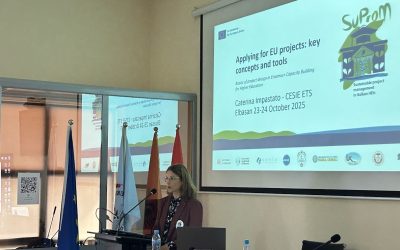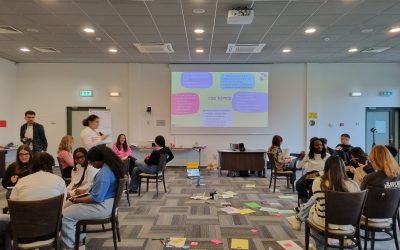In 2022, over 10,000 victims of trafficking in human beings (THB) were registered across the European Union. Yet, the true number is likely much higher. Many victims remain undetected, often hidden within broader migration flows or trapped in systems unable to recognize their vulnerabilities. The majority of identified victims are women and girls from third countries, trafficked for sexual exploitation — though cases of labour, criminal, and other forms of exploitation are also rising.
Despite the progress achieved through European legislation and cooperation frameworks, the risk of trafficking remains high, especially for people seeking international protection. Smuggling and trafficking frequently overlap along the routes to Europe, where organized criminal networks exploit migrants’ vulnerabilities and the gaps in protection systems. Reception centres, initially designed as safe spaces, sometimes become recruitment grounds for traffickers and smugglers. This complexity demands a coordinated, multi-layered response at EU level.
From the Common European Asylum System to the Anti-Trafficking Directive: Progress and Blind Spots
At European Union (EU) level, the legal and policy framework addressing these challenges is anchored in two major pillars. The first is the Common European Asylum System,which encompasses the Asylum Procedures Directive, the Reception Conditions Directive, and the Qualification Directive — together aiming to harmonize standards of protection across Member States. The second is the Directive on preventing and combating trafficking in human beings and protecting its victims, which was recently revised in 2024 to better respond to digital forms of exploitation and to strengthen victims’ access to justice, compensation and long-term support. These frameworks are complemented by the EU Strategy on Combatting Trafficking in Human Beings (2021–2025) and the EU Pact on Migration and Asylum, which is currently being operationalized in Member States. Both stress the need for early identification of victims, the establishment of coordinated referral mechanisms, and stronger partnerships between countries of origin, transit, and destination.
Yet, implementation remains uneven. Frontline professionals often lack the training or tools to recognize victims, especially within asylum and reception systems. Digital recruitment and cross-border exploitation schemes evolve faster than institutional responses. Moreover, access to assistance and protection continues to vary widely — depending on the victim’s nationality, legal status, or the form of exploitation experienced.
Across Europe, recent reports highlight the same persistent gaps: inadequate early detection, fragmented inter-agency coordination, and insufficient victim-centered approaches. These challenges are particularly visible in countries under migratory pressure such as France, Italy, and Greece, where reception systems are overstretched and where the boundaries between migration management, asylum, and anti-trafficking efforts often blur.
From awareness to action: the REACHing project
Against this backdrop, the REACHing project aims to enhance the detection, protection, and empowerment of victims of trafficking within asylum and reception systems across partner countries.
The project’s innovative approach is based on the creation of mobile teams of expert social workers specialized in trafficking and asylum. These teams will operate across different structures — from registration platforms and accommodation centres to integration programmes — providing on-site assistance, capacity building, and direct support to victims and frontline professionals.
By sharing methodologies, tools, and expertise across borders, REACHing seeks to strengthen the operational capacities of institutions, harmonize practices, and ultimately ensure that no victim goes unnoticed. The initiative is expected to directly benefit over 5,000 people across the three partner countries, fostering a more coherent and victim-centered European response.
Beyond Legislation: Rights, Dignity and Cooperation in the Fight Against Trafficking
The fight against human trafficking is not only a matter of law enforcement, but also of social justice and human rights. Effective protection depends on cooperation — between institutions, professionals, and communities. By linking national asylum systems with specialized anti-trafficking mechanisms, REACHing contributes to the broader EU objective of building an integrated and rights-based migration management system.
As Europe continues to operationalize the Pact on Migration and Asylum, projects like REACHing demonstrate how policy commitments can be translated into practical action — ensuring that protection frameworks work for those who need them most. Through stronger networks, enhanced training, and coordinated mobile responses, the project aims to reach those who remain invisible — and to help them rebuild their lives in dignity and safety.
About REACHing
REACHing project – REinforcing Assistance to viCtims of Human trafficking – was launched in 2025 with support from the EU’s Asylum, Migration and Integration Fund (AMIF).
Partners
- FORUM REFUGIES – Forum (France, coordinator),
- CESIE ENTE DEL TERZO SETTORE – CESIE ETS (Italy),
- FONDAZIONE INTERNATIONAL RESCUE COMMITTEE ITALIA ETS – IRC Italy (Italy),
- ELLINIKO SYMBOULIO GIA TOYS PROSFYGES – GCR (Greece),
- Mission interministérielle pour la protection des femmes contre les violences et la lutte contre la traite des êtres humains – MIPROF (France),
- UNIVERSITE CLERMONT AUVERGNE – UNI CLERMONT (France).
For further information
Contact Luciano Cortese, luciano.cortese@cesie.org









